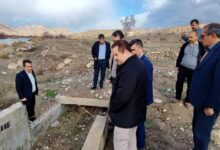دحیه کلبی; From Yemen to Darabgard

The history of Iran has many signs of civilization in different eras; The main surviving symbols of the past are ancient and ancient buildings and sites, and an important part is related to influential personalities, individuals or persons who have been distinguished by their position of government, spirituality, science and و and whose names have remained in history.
Indeed, the permanence and importance of monuments and historical monuments is also due to their connection with an individual or a group of people in human society who had a place at that time; However, in the case of many buildings, the names of the sultans, rulers, scholars, and thinkers who built them by order or order have been mentioned and highlighted in history, rather than the name of the designer, architect, and builder.
According to ISNA, all over Iran, full of artifacts, are monuments that have their roots in the ancient past of this region, a history from millennia BC to recent centuries, and certainly many of them are unknown to most people, even Iranians. . In the meantime, not only buildings and monuments, but also personalities are considered very important due to their influence during the historical course of Iran; People that most of us have probably heard less about.
Dahiyeh Kolbi is one of these historical figures; A person whose traces can be found in influential events during the very important period of the beginning of Islam, this companion of the Prophet is considered to be one of the unknown group for many Iranians; However, some people interested in history and historical places, and of course the residents of the east of Fars province and even the southeast of the country, have heard this name; A name that reminds familiar listeners of a tomb on the outskirts of the old city of Darab, or Darabgerd (Darabjerd).
Dahiya Ibn Khalifa Kalbi, known as Dahiya Kalbi, was one of the companions of the Prophet Muhammad (PBUH) who converted to Islam after the battle of Uhud, but became one of the close relatives of the Prophet of Islam, so much so that he chose him as his messenger and to everyone. The Byzantine emperor sent. This Islamic figure, after the Prophet, also understood the life and presence of Imam Hassan Mojtaba (AS) for many years, and according to documents and narrations from that Imam, he left for Iran and the city of Darabgard, and now, a tomb named after him is on its outskirts. There is a city.
In this article you will read:
Darab and Darabgard
Darab is one of the centers of gravity of Iranian Islamic civilization and culture; Where in historical texts it is mentioned as Darabgard and Darabjard and has been a very important point of Abadan and Markazi and the settlement of people in this region and its prosperity, even dates back to the prehistoric millennia. However, over the past years, it has not been very favored and has not witnessed effective and continuous excavations and actions like other historical buildings and sites.
The historical background of Darab, according to archeological reports, dates back to the fifth millennium BC, and in the latest excavations in Hirbadan hill, but the results of which have not yet been published, archaeologists have found credible evidence of this historical background.
The historical and civilizational resources of Darab in different periods from the millennium BC to the Achaemenids, Sassanids, etc. are so abundant that the importance of this point is noted; But one of the ancient treasures of this fertile and prosperous land is the existence of a tomb that has been less studied.
Darabgard ancient site
Darabgard has been considered as one of the populated areas of Iran in different periods of history and many historians and researchers have mentioned it as a prosperous region and Abadan.
The foundation of Darabgard was laid during the Achaemenid period, a circular city with special architecture and unique fortifications, which in some periods was the center of government and therefore the place where many personalities came and went and is the burial place of some of them. Characters such as Dahiya bin Khalifa Kalbi.
The most important or one of the most important remnants of Darab’s past is an area called Darabgard, which is considered a unique structure in the world due to its architectural and structural features. Although in Iran we have not been very kind to it.
Mohammad Baqer Mohajer, professor of history at Darab University, told ISNA in this regard: Darabgerd is the most important circular city in the world, which has a special and unique plan and the wall around it is the largest mud wall and a moat dug around it is the largest moat in its time. have been.
He noted that Darabgard dates back to the Achaemenid period: Of course, archeological excavations carried out in the early 1980s by a group of explorers accompanied by a British archaeologist showed that Darabgard was also in prehistoric times. It has been human habitat.
The faculty member of Darab University emphasized that according to historical texts and writings, Darabgard has been considered as one of the prominent and important cities of Iran in different periods. Before that period, Darabgard was considered as an Abadan region in the east of Persia and a road called Istakhr-Darabgard was considered as the connection route between this city and Persepolis.
Expressing the importance of Darabgard city in the Islamic era, this professor of history also said: to realize the importance of Darabgard, it is enough that the name of this city is mentioned in the peace treaty of Imam Hassan (AS) and Mu’awiyah and that the city’s tribute is mentioned as a guarantee for the implementation of the treaty. It has shown prosperity and prosperity. In such a way that the amount of Darabgard tribute at that time can be compared with developed cities such as Hamedan.
Muhajer also pointed to the existence of a tomb attributed to one of the most important figures of early Islam near Darabgard and added: Dahiyah ibn Khalifa Kalbi, one of the companions very close to the Prophet Muhammad (PBUH) during the rule of Mu’awiyah over the world Islam had traveled to this region.
Mohajer said that very limited research has been done on this character and the existence of his tomb in Darabgard, adding: “One of the most important documents about Dahiyeh Kolbi is the book written by Dr. Mirza Mohammad Hassani.”
دحیه کلبی
Dr. Mirza Mohammad Hassani, writer, researcher and professor of history, as one of the few scholars who has done research on Dahieh Kolbi and published it in the form of a book, told ISNA: Dahieh Ansari, companions and very close people And he was trusted by Prophet Mohammad, the Holy Prophet of Islam (PBUH) whose name has been mentioned many times in history books. During the resurrection of Prophet Mohammad (PBUH), as his representative, he took the letter of invitation to the Prophet’s Islam to the Byzantine emperor to his court.
This university professor reminded that according to authentic documents, Dahiyeh was alive until the year 45 AH, that is, during the reign of Mu’awiyah, and by stating that in some historical documents, Dahiyeh lived in that village (the last years of his life) in a village called “Mezeh”. Near Damascus, it has been mentioned, he said: There is no accurate information and documents about the presence, residence and death of Dahiyeh in Darabgard, but based on the few available evidences and documents and texts from historical documents, the tomb of the companions of the Prophet is located on the outskirts of Darabgard. has it.
Dahieh descendants live in Darab
This professor and researcher in the field of history, regarding the claim of a family of descendants of Dahiya in Darab, noted: No person or family that is the grandson of the companions of the Prophet has been identified in the city of Darab. .
Recalling that the tomb of the Companions of the Prophet is located on the outskirts of Darabgard city and near the current city of Darab, Hassani said that the moat around Darabgard city has become famous over time to Dahieh moat, he added: Given that, tombs are attributed to him in other parts of the world, including Damascus.
Referring to the historical texts and the researches that he has personally done in this regard, he said: In the authoritative historical texts, issues have been raised about the peace treaty of Imam Hassan Mojtaba (AS) with Mu’awiyah and the issue of allocating Darabgard tribute to that Imam. Is. It is possible that Dahiyeh went to Darabgard as a representative of that Imam with the aim of collecting tribute, although there is no report in the historical texts about his departure to Darabgard. It is worth mentioning that the historical texts state that the people of Basra opposed the allocation of Darabgard tribute to Imam Hassan (AS) and this issue may not have been realized.
He added: “Based on the little historical evidence available, it is possible that Dahiyeh died or was martyred in Darabgard at the same time, but there is no direct report in this regard.”
Regarding the reason for requesting the Darabgard tribute from Imam Hassan (AS), Hassani said: According to the available documents, that Imam had requested the Darabgard tribute to pay to the martyrs of the Jaml and Safin wars.
Rejection of Dahiya in the new history of Yazd
This professor and historical researcher pointed out: The oldest historical evidence about the location of the tomb of Dahiyeh Kalbi in Darabgerd or Darabjerd is a book entitled “The New History of Yazd” written by Ahmad Ibn Ali Katib and contains events up to 862 lunar years.
Reminding that the book is related to the ninth century AH, he said: In a part of this book that mentions the elders buried in Yazd, it is stated that the tomb of Maulana Morteza Azam, first and in 815 near the tomb of Dahieh Kolbi He was in Darabjerd and later transferred to Yazd by his relatives.
Hassani pointed out: “Another document that exists about the existence of the tomb of Dahiyeh Kalbi is the documents and evidence obtained during the reconstruction of that tomb.”
This professor of history said: In 1381, during the reconstruction of the current tomb of Dahieh, a tombstone was found at a depth of 3 meters. The date of this tombstone is 820 AH. This tombstone refers to the restoration and replacement of tombstone in the aforementioned history. Therefore, this tombstone was installed on Dahiyeh tomb after replacing the previous and older tombstone.
He added: “Another piece of evidence is the comparison between Eugene Flandin’s paintings of Darabgard and the current state of the area;” In the graphic painting of this French tourist and engineer at the beginning of the Qajar period, we encounter a picture of Dahiyeh tomb on the outskirts of Darabgard. Examination of the image with examples of similar tombs proves that the tomb of Dahieh was built at the beginning of the Qajar period from the period of the Mongol ilkhans. Therefore, with this pictorial document, the history of Dahiyeh tomb can be traced back to the seventh century AH.
Hassani added: “Another possibility is that, considering the tombstone found at a depth of three meters, the history of the tomb can be traced back to the fifth century, because in the Seljuk period, the burial method was in the crypt and deep in the ground.” It has been customary.
This professor of history reminded that he has mentioned all the evidences and documents in his book entitled “History of the tomb of Dahieh Kolbi in Darabjard”, in the end, in response to the question of who built this tomb in the beginning, There is no specific document, but referring to history, it can be seen that the Ilkhans and Timurids had a lot of devotion and respect for dervishes, mystics, Zahedan and..
What is certain is that the current building has nothing to do with the original tomb and the tomb has been completely renovated.
Darab calls us
Darab, which is one of the 37 cities of the vast province of Fars, is definitely one of the most important destinations for travel; A place that, in addition to its impressive historical background and the monuments, buildings and sites that it has placed in its heart from different eras, is spectacular in terms of visual beauty and diversity of climatic conditions.
A trip to Darab, in addition to taking us to the Sassanid era! It has natural points in its heart, each of which will surprise every viewer in terms of visual beauty. Gol Mohammadi refinery gardens, springs, reservoirs, plains, mountains, etc. Each is a manifestation of the power of the One Creator.
Director of Cultural Heritage, Tourism and Handicrafts of Darab city, in this regard, said: Darab city has 97 national registered works in the field of historical, natural and intangible heritage, of which 92 buildings, monuments and historical sites, 3 national works and 2 It is an intangible heritage.
Hadi Moradi reminded that for some of the works in this city, the registration file has been formed or is being formed in the national list, and said: The tomb of Dahbeh Kolbi is one of the important religious historical monuments of Iran and Persia, which has not been nationally registered yet, but Follow-up to record it can be a priority.
Moradi also announced the beginning and implementation of the first phase of important excavations, the findings of which tie the human biological background in the Darabgard area to the Elamite period and even before that.
Source: ISNA

